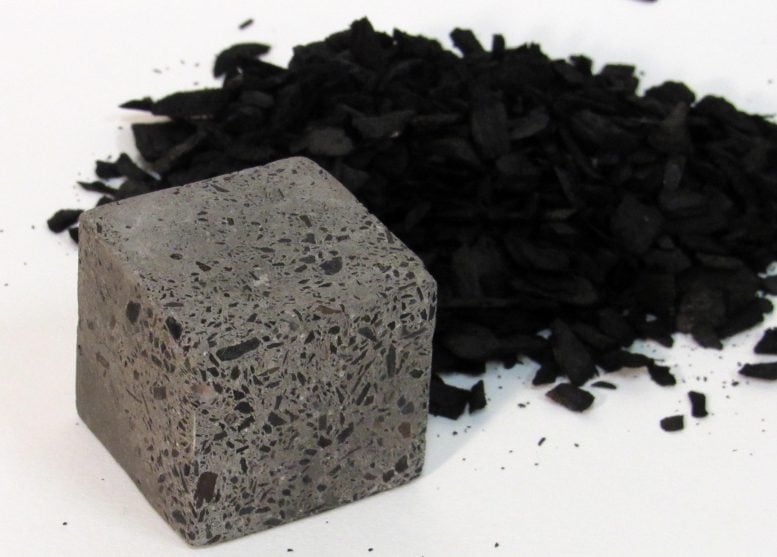博文
Science:创新材料将建筑变成巨大的碳汇
||
Science:创新材料将建筑变成巨大的碳汇
诸平
据美国加州大学戴维斯分校(University of California – Davis简称UC Davis)2025年1月9日提供的消息,创新材料将建筑变成巨大的碳汇(Innovative Materials Turning Buildings Into Massive Carbon Sinks)。加州大学戴维斯分校(UC Davis)和斯坦福大学(Stanford University)研究人员的一项新研究,将二氧化碳储存在普通建筑材料中可以帮助解决气候变化目标。由于全球每年生产的混凝土数量非常大,将碳加入混凝土将特别有影响。上图为用生物炭材料制成的混凝土块。
根据这项新的研究,发现日常建筑材料如何成为大量碳储存的关键。混凝土中的生物炭和生物质塑料等技术可以将建筑物变成碳汇(carbon sinks),推动经济和环境进步。
建筑材料中的碳储存(Carbon Storage in Construction Materials)
根据加州大学戴维斯分校和斯坦福大学的研究人员最近的一项研究,混凝土和塑料等建筑材料可能在储存数十亿吨二氧化碳(CO2)方面发挥重要作用。2025年1月9日发表在《科学》(Science)杂志网站的这项研究,强调了如何将二氧化碳储存纳入建筑物,以及努力使经济脱碳,可以帮助实现全球温室气体减排目标。原文详见:Elisabeth Van Roijen, Sabbie A. Miller, Steven J. Davis. Building materials could store more than 15 billion tons of CO2 annually. Science, 2025, 387(6730): 176-182. DOI: 10.1126/science.adq8594. Published: 9 January 2025. https://www.science.org/doi/10.1126/science.adq8594
这项研究的主要作者、加州大学戴维斯分校的前研究生伊丽莎白·范·罗伊恩(Elisabeth Van Roijen)说:“潜力非常大。”伊丽莎白·范·罗伊恩现在是美国能源部国家可再生能源实验室(U.S. Department of Energy National Renewable Energy Laboratory)的一名研究员。
重新思考碳封存(Rethinking Carbon Sequestration)
碳封存包括直接从二氧化碳源或从大气中捕获二氧化碳,使其稳定,并以防止其导致气候变化的方式将其储存起来。传统的方法包括将二氧化碳注入地下或将其储存在深海中,但这些选择都存在技术障碍和环境风险。
“相反,如果我们可以利用我们已经大量生产的材料来储存碳呢?”伊丽莎白·范·罗伊恩说。
探索建筑材料中的碳捕获(Exploring Carbon Capture in Building Materials)
伊丽莎白·范·罗伊恩与加州大学戴维斯分校土木与环境工程副教授萨比耶·米勒(Sabbie A. Miller)和斯坦福大学的史蒂文·戴维斯(Steven J. Davis)合作,计算了在广泛的普通建筑材料中储存碳的潜力,包括混凝土(水泥和骨料)、沥青、塑料、木材和砖。每年全球生产的这些材料的传统版本超过300亿吨。
混凝土具有千兆吨的潜力(Concrete’s Gigaton Potential)
研究的储碳方法包括将生物炭(通过加热废生物质制成)加入混凝土中;使用可装载碳的人造岩石作为混凝土和沥青路面骨料(asphalt pavement aggregate);基于生物质而非化石石油来源的塑料和沥青粘合剂;并将生物质纤维加入到砖块中。这些技术处于不同的准备阶段,其中一些仍在实验室或试点规模进行研究,而其他技术已经可以采用。
研究人员发现,虽然按重量计算,生物基塑料可以吸收最多的碳,但到目前为止,最大的碳储存潜力是使用碳化骨料(carbonated aggregates)制造混凝土。这是因为到目前为止,混凝土是世界上最受欢迎的建筑材料:每年生产超过200亿吨。
萨比耶·米勒说:“如果可行的话,在混凝土中储存一点会有很长的路要走。”该团队计算出,如果世界上10%的混凝土骨料是可碳化的,它可以吸收十亿吨二氧化碳。
生物基创新和循环经济(Bio-Based Innovations and Circular Economies)
伊丽莎白·范·罗伊恩说,这些制造建筑材料的新工艺的原料大多是低价值的废物,如生物质。她说,实施这些新流程将提高它们的价值,创造经济发展,促进循环经济。
需要一些技术发展,特别是在必须验证个别制造方法的材料性能和净储存潜力的情况下。然而,萨比耶·米勒说,许多这些技术只是在等待被采用。
这项工作得到了美国国家科学基金会(National Science Foundation, grant CBET-2143981)、美国加州大学多校区研究项目和倡议(UC Multicampus Research Programs and Initiatives of the University of California, grant M23PL6005)、美国加州绿色建筑研究中心(California Center for Green Buildings Research, grant M23PL6005)的支持。
上述介绍,仅供参考。欲了解更多信息,敬请注意浏览原文或者相关报道。
The quantity and relative longevity of structural materials used in the built environment could make them attractive for carbon dioxide removal. Although many of these materials are currently net carbon dioxide emitters, Van Roijen et al. outline how several of them could help lock up carbon for decades (see the Perspective by Bataille). Transitioning to carbon storage can be accomplished with relatively minor changes to the composition, such as using carbon-rich aggregates in concrete or biomass fiber–based brick. Implementing all of the modifications suggested by the authors could sequester roughly half of yearly carbon dioxide emissions and may be an important tool for getting to net zero emissions. —Brent Grocholski
Achieving net-zero greenhouse gas emissions likely entails not only lowering emissions but also deploying carbon dioxide (CO2) removal technologies. We explored the annual potential to store CO2 in building materials. We found that fully replacing conventional building materials with CO2-storing alternatives in new infrastructure could store as much as 16.6 ± 2.8 billion tonnes of CO2 each year—roughly 50% of anthropogenic CO2 emissions in 2021. The total storage potential is far more sensitive to the scale of materials used than the quantity of carbon stored per unit mass of materials. Moreover, the carbon storage reservoir of building materials will grow in proportion to demand for such materials, which could reduce demand for more costly or environmentally risky geological, terrestrial, or ocean storage.
https://blog.sciencenet.cn/blog-212210-1468270.html
上一篇:肺移植领域的里程碑:体外光移植术改善了排斥反应和感染率
下一篇:科学家如何利用原子精度来强化化学反应
